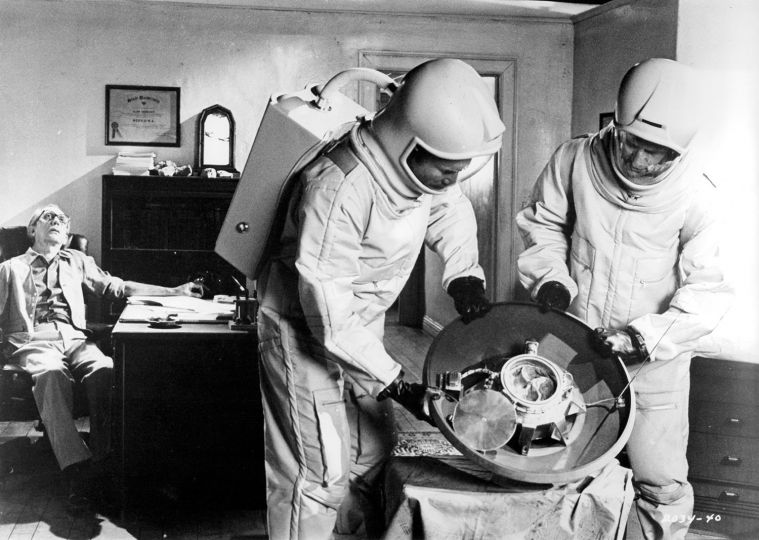
Could Mars samples brought to Earth pose a threat to our planet? What the coronavirus (and 'Andromeda Strain') can teach us.

NASA and the European Space Agency plan to haul pristine Mars samples to Earth in the near future, perhaps in the 2030s.
Receiving pieces of the Red Planet in this way is deemed to pose a low risk to ecological and public safety — but that risk is not zero.
The Mars samples, which will be collected and cached by NASA's Perseverance rover, could end up being biological "hot property." And the material might spark heated debate and public anxiety about creepy-crawlies from Mars chomping away at Earth's biosphere.
Related: The search for life on Mars (a photo timeline)
Hauling back the goods from the Red Planet resonates in some ways as a replay of Michael Crichton's 1969 novel "The Andromeda Strain," which dramatized the idea of alien organisms infecting Earth.
In the book, which was made into a film in 1971, alien germs are brought to Earth by a "Project Scoop" satellite. An elite team of secretive first responders, clad in protective hazmat suits, studies and battles the bug within a hush-hush, high-tech underground facility named Wildfire.
Will this scenario forever remain science fiction, or could it actually happen in real life? And does the ongoing coronavirus pandemic hold any clues about how to handle samples brought to Earth from Mars, a place that could potentially host extraterrestrial microbes?
Breaking space news, the latest updates on rocket launches, skywatching events and more!
Stringent containment
The public certainly should pay more attention to plans for Mars Sample Return, said Cassie Conley, a former NASA Planetary Protection Officer.
"Since the beginning of space exploration, planetary protection has mandated that samples from Mars should be considered 'Restricted Earth Return,' Conley told Space.com. "This requires the most stringent containment to protect both the samples and the Earth."
However, in 2019, NASA's Planetary Protection Independent Review Board recommended lowering the planetary protection category for much of Mars' surface to Category II, which would eliminate any requirement for oversight or containment of samples returned from parts of Mars, Conley said.
"We really don't understand Earth biology very well and certainly don't know that much about Mars," Conley said. "So, it's premature to conclude there are no Martian biohazards."
Conley said that "the current pandemic demonstrates, tragically well, how overconfidence and short-term perspectives can cause catastrophic harm to people all over the Earth."
Related: The boldest Mars missions in history
Molecular locks and keys
"It seems to me that public interest in Mars Sample Return safety issues would likely be sharpened by experiences of the COVID-19 pandemic," said J. Andy Spry, a senior scientist at the SETI (Search for Extraterrestrial Intelligence) Institute in California and a NASA planetary protection consultant.
This would hopefully occur "in the same way that the SARS epidemic sharpened the responses of many Asian countries to the COVID-19 hazard," Spry said. "That is, by allowing decision-makers to develop appropriate and timely responses to a microbial pathogen threat."
That said, Spry added, such pathogens usually develop by coexisting with life on Earth, with highly specialized outbreak adaptations as part of an ongoing host-pathogen interaction.
"We can think of pathogenicity as molecular locks and keys which are virtually impossible to develop without repeated contact," Spry said. "Thus, it is extremely unlikely for a biological entity evolving and adapting in an extraterrestrial environment to be able to take advantage of lifeforms on Earth."
Containment facility
While major spacefaring nations share a common perspective on containment of Martian material returned to Earth by a spacecraft, Spry also underscored the international Committee on Space Research (COSPAR) policy language that "no uncontained hardware that contacted Mars, directly or indirectly, shall be returned to Earth." However, implementation details — including those for a containment facility — have yet to be fully worked out, he said.
"This is only because the details of the current Mars sample return mission architecture are still being studied and refined by NASA and the European Space Agency right now," Spry told Space.com. "In the latest scheduling, we are still some 15 years from samples actually being returned to the Earth-moon system, which is still timely in terms of getting containment facility work done."
First things first
Astrobiologist Dirk Schulze-Makuch at Washington State University has been a longtime advocate for having an on-the-spot life-detection mission on Mars first, before attempting sample return.
"We do have the technology to do so. That way we would also have a better idea what we might bring back," he told Space.com. (Perseverance, which will launch this summer, will hunt for signs of Mars life on the Red Planet's surface. But the rover will look for evidence of ancient, not extant, organisms.)
Schulze-Makuch said that a retrieval facility would have to have a high biosafety level, just in case. The chance that any life from Mars would be in any way harmful to us or Earth's biosphere at large is extremely low, he said. He thinks that chance is lower than 1%, but it cannot be totally excluded.
"So, I think the public and planetary protection guidelines would warrant a high biosafety level retrieval facility (3 or, better, 4), which, of course, has a very high price tag as well," Schulze-Makuch said. "And since samples can only be brought back once such a facility is in operation, it will also delay the schedule until we can bring samples back. And if so, we should bring rather 'fresh' samples back, not samples that have been in a box on Mars for years — as is the plan right now."
Heated discussion
One thing to keep in mind, Schulze-Makuch said, is that Earth has already gotten Mars samples — lots of them, in fact, over the eons. Many Mars meteorites have landed on Earth, after all, potentially bringing Martian microbes — if they exist — to our planet.
"Studies have shown that the interior, for example, of Mars rock ALH84001 was never heated above 40 degrees Celsius [104 degrees Fahrenheit], and if there would have been (dormant) microbes in it, they would likely have survived the journey from Mars to Earth," Schulze-Makuch said.
And, of course, there is a heated discussion about whether some Martian meteorites — most notably, ALH84001 — contain evidence of Martian microbial life.
"Either way, the point is that there is also a natural 'mechanism' to bring potentially Martian life to Earth … and if that didn't have detrimental consequences for life in the past, it is unlikely that it will have those in the future," Schulze-Makuch said. "But again, we have to admit that the risk is not zero."
- Mars sample return: scientists debate how to bring Red Planet rocks to Earth
- The 7 biggest mysteries of Mars
- Why we can't depend on robots to find life on Mars
Leonard David is the author of the book "Moon Rush: The New Space Race," published by National Geographic in May 2019. A longtime writer for Space.com, David has been reporting on the space industry for more than five decades. Follow us on Twitter @Spacedotcom or Facebook.
OFFER: Save 45% on 'All About Space' 'How it Works' and 'All About History'!
For a limited time, you can take out a digital subscription to any of our best-selling science magazines for just $2.38 per month, or 45% off the standard price for the first three months.

Leonard David is an award-winning space journalist who has been reporting on space activities for more than 50 years. Currently writing as Space.com's Space Insider Columnist among his other projects, Leonard has authored numerous books on space exploration, Mars missions and more, with his latest being "Moon Rush: The New Space Race" published in 2019 by National Geographic. He also wrote "Mars: Our Future on the Red Planet" released in 2016 by National Geographic. Leonard has served as a correspondent for SpaceNews, Scientific American and Aerospace America for the AIAA. He has received many awards, including the first Ordway Award for Sustained Excellence in Spaceflight History in 2015 at the AAS Wernher von Braun Memorial Symposium. You can find out Leonard's latest project at his website and on Twitter.




